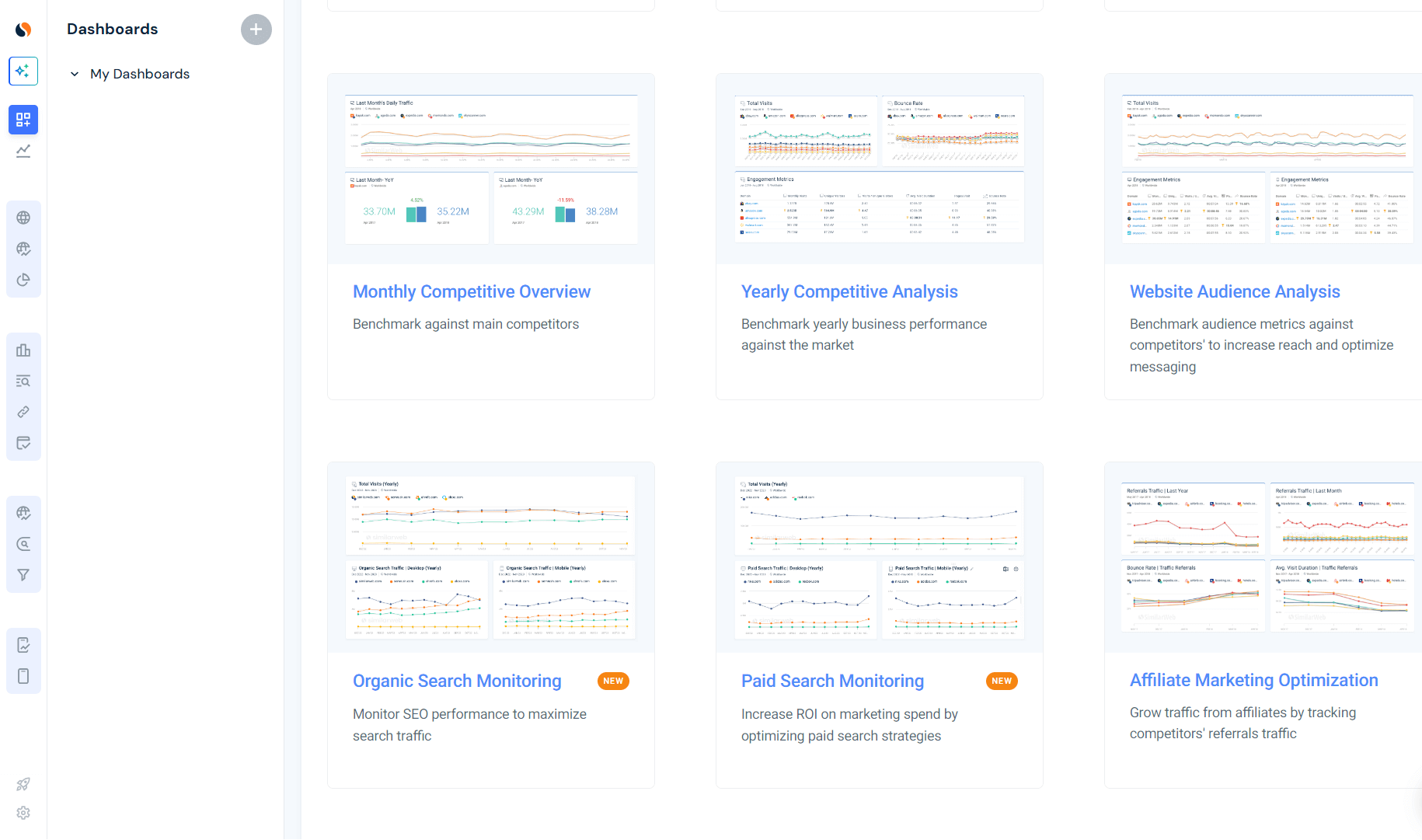How to Increase Paid Traffic to Your Website Without Increasing Your Budget

All marketers and PPC specialists wish to drive more visitors to their websites without increasing the existing budget. Usually, it sounds like a utopia, but it actually isn’t! Similarweb’s data-driven insights might help you discover more. Through fine-tuning of advertising tools and effective use of data, your website traffic can be increased while your budget stays under control. In this article, you can read about the ready-to-use solutions to reach these goals and all of these without additional costs.
What is paid traffic?
Paid traffic is traffic that visits your website as a result of a paid advertisement, as opposed to an organic (unpaid) listing. This type of traffic shows up as ads in search results, in social media, on web pages and other places around the internet. Advertisers usually pay on a cost-per-click (CPC) or cost-per-thousand-impressions (CPM) basis, only paying when somebody clicks.
For example, Google Ads, Facebook Ads and banner ads across various sites. Although the aim is different, paid traffic does what the name says: it attracts customers, fast and efficiently, getting you in front of people instantly and boosting sales or activity – for a price.
Why is paid traffic important?
If you do any marketing, you need to understand why paid traffic is so valuable. There are many benefits that paid traffic can bring, which makes it a great investment:
Immediate results
Probably the most advantageous feature of paid advertising is the immediacy it offers. Unlike the slower, organic ways of achieving more traffic or exposure, paid ads will provide you with immediate response – often, even with minutes of launching a paid marketing campaign, you’ll start receiving traffic. Any business that needs exposure immediately – like when they’re launching a new product or a special promotion – will benefit greatly from this immediate effect of paid marketing.
Targeted reach
Having more precise control over who sees your ads is another crucial advantage. Paid ads allow you to pinpoint specific demographics, interests and behaviors so that ads will appear in front of users who will be most receptive to them. This, in turn, increases conversions and the overall return on investment for the business. Businesses that are targeting niche markets or a specific type of customer profile can take advantage of this feature.
Measurable data
Paid advertising channels let you measure PPC performance metrics with precision. Thanks to platforms like Google Ads, you can track clicks, impressions, conversions and other metrics to see how your campaigns are performing and make changes to keep them responsive to changing market demands. The ability to make decisions based on data will keep your paid advertising strategy lean and mean.
Flexibility and control
Unlike other advertising options, PPC allows you to adjust your budget per your own needs and business goals at any point. You can turn a campaign on or off at your discretion, increase or decrease your daily budget, or change your audience targeting based on performance metrics. In this way, you can adjust your budget and strategy as needed and get the most out of your money.
Top paid traffic sources
Paid advertising will be more effective if you really understand the main sources of paid traffic. Each platform has its own benefits that will help you on your way to running great campaigns.
Google Ads
Google Ads continues to hold the number one spot with a wide-reaching, versatile campaign mix. Search Ads, Display Ads, YouTube Ads, Discovery Ads — you can pick any one of these depending on your advertising plan. These features allow you to customize your advertising strategy for cross-platform use.
You can also specify keywords so your ads show up when users look for something. Additionally, Google Ads has machine learning-powered automated bidding options including conversion-targeting and conversion value-targeting to make your ad more efficient. With Google’s deep analytics, you can easily analyze and constantly adjust your campaigns for optimal outcomes.
Facebook Ads
Facebook Ads allow advertisers to target demographics based on age, location, interests and behaviors, as well as image or video viewers and lookalike audiences. Given the visual nature of the platform, these full-bodied ads are a great medium to pull in users’ attention, with helpful performance insights through Facebook’s analytics tools that allow companies to optimize campaigns.
LinkedIn Ads
LinkedIn Ads are ideal for organizations targeting professionals, especially those offering B2B solutions. Advertisers can target specific groups of professionals based on industry, job title, company size and more. This level of specificity is what makes LinkedIn a good choice for marketers reaching out to other businesses. By reaching out to the right people, you can boost the quality of your leads and generate more conversions.
YouTube Ads
YouTube Ads capitalize on the captivating nature of video and can provide the visibility you’re looking for. These skippable and non-skippable ads can show before the start of videos, in the middle, or at the end of videos, to deliver your message.
Instagram Ads
Instagram is an ideal channel for brands targeting visually oriented users and those that want to present their goods in a creative way as. Having been acquired by Facebook, it offers similar powerful targeting abilities. Some of the advertisements on Instagram are very creative and will definitely grab the viewers’ attention.
How to check paid traffic that’s coming to your site
You should always monitor the paid traffic that is sent to your site because it can indicate the overall effectiveness of your campaign. There are many tools and methods that can check and analyze your paid traffic thoroughly:
Google Analytics
You need to track the traffic that visits your website to get an idea of whether your site is working well or not. Google Analytics is a helpful tool that is crucial for tracking your traffic so that you can understand the behavior of your visitors, all the sources of traffic you have, and to see whether your paid campaigns are successful or not. In order to do that, you have to set up goals and conversions to track your advertisements. All of these insights can be of great help when you plan and organize your next strategy in order to be more efficient.
Paid traffic reports
Almost every advertising platform includes a reporting tool. Google Ads is a platform where you get real-time, detailed performance reports that show you the number of clicks, impressions, CPC and conversion rates for a particular period of time. The same goes for Facebook Ads Manager and LinkedIn Campaign Manager, which have built-in detailed metrics that allow you to keep track of your paid results without paying a dime.
Similarweb
Having good data is half the secret to your success. It will allow you to control and optimize your paid traffic strategy the best possible. Similarweb’s data is among the freshest and most accurate on the market, and will offer useful insights that can help you manage and optimize your paid traffic. The platform offers a full range of PPC tools to check paid traffic, and you can access it in 2 ways:
Click on “Website Analysis” and “Search” and then “Paid Overview”. This report not only contains paid traffic, the most used paid keywords, and paid search traffic engagement metrics but it can even show you your PPC spend and traffic as well as competitors’. Utilizing Similarweb’s data to perform paid competition research allows you to see the keywords holes, and where you can grow your traffic by targeting phrases where your competitors have an edge. It is much more revealing than tracking just how much you spend yourself and doing so alone.
Go to Dashboards and make a custom report. It lets you track your paid traffic, over time and on various campaigns, so you’ll have a more holistic understanding of how well you’re doing and easier way to forecast PPC traffic.
How to increase paid traffic to any website
How do you bring in more paid traffic to your website without growing your budget? Here are some smart ways to optimize your ads and convert more visitors:
Keyword optimization
Your ad campaigns will get better once you concentrate on high-performing keywords. If you want to know what are your best keywords, there are different tools on the market that will help you identify which keywords give you more traffic.
If you focus on these keywords, web traffic will get better and you won’t have to spend extra money to achieve this. Keyword optimization is key to making sure that people who will be interested in your product see your ads.
Refine your targeting
If you don’t target the right audience as your customer pool, you’ll waste ad spend. If you optimize your ads to hit demographic and psychographic audience profiles, you’ll be able to hit those most likely to convert, and on platforms such as LinkedIn Ads, you can refine them down to very nuanced targeting levels to segment your audience.
The more precise you can get in your targeting, the cheaper your ad spending will be because you’re not targeting broad, less-responsive audiences.
Improve ad quality
High-quality ads are more likely to be noticed and clicked on, so focus on creating good ad copy and images that will resonate with your target audience. A/B testing can determine the winning ads, and so is an efficiency worth investing in. Ad quality is something you can control, so the more time you put into it, the richer the user experience and the better the ad campaign performance.
Get insights from Similarweb
If you want to enhance your paid traffic to your site, Similarweb can help. Here is how to access the tools to make the best of it:
To access details of your paid search traffic, head to ‘Website Analysis’, then ‘Search’, and finally ‘Paid Overview’.
Go to Search Intelligence > Keyword Research > Website Explorer > Keywords and click on the ‘Paid Traffic’ tab to analyze paid keywords performance.
Next, head to ‘Search ads’ under ‘Website Explorer’, and you’ll uncover extensive metrics on your ad performance and potential optimization opportunities.
Measure and track your paid traffic growth and ROI
You can’t manage what you can’t measure. Once you start buying traffic, it’s vital to track it accurately so that you can continue to refine your strategy to keep the figure moving in the right direction. Here’s how:
1. Set clear goals
First, set specific goals for what your paid traffic campaigns should accomplish. Are you simply looking to drive more traffic to your website, generate more leads, or increase sales? The reason why this is important is that you’ll be able to measure success more effectively. Whatever your goal (for example, generate more leads), you can use that to assess how effective your campaigns are and let that guide your optimizations.
2. Utilize analytics
This data is available through free applications such as Google Analytics, which tracks your click-through rates (CTR), conversion rates and cost-per-acquisition (CPA). You’ll get a blunt picture of exactly how your campaigns are performing, and where opportunities for optimisation lie. You can even set up custom dashboards that filter the results to make it easier to see how you’re faring in real time.
3. Optimize budget allocation
Test your campaigns regularly to see which ads perform best, and direct more spend to those ads, while reducing spend on low-performing ads. Budget optimization in this way has several benefits. It focuses advertising spend on the most effective parts of the campaign, and leads to better results through more efficient spending of advertising budgets, without the need to increase the budget itself over time.
4. Use Similarweb
Similarweb has powerful tools you can utilize to analyze paid traffic growth and ROI:
To access your paid search traffic analytics, click over to ‘Website Analysis’, then ‘Search’, and then ‘Paid Overview’.
Dashboards can be used to create graphs to monitor key performance indicators over time and plan strategies to maximize growth.
Now it’s up to you
If you want to increase your paid traffic without increasing your budget, you will have to plan very well and use the most useful tools to support you. If you follow the techniques we’ve discussed and use Similarweb, you will be able to reach your traffic targets much quicker and more efficiently.
Remember that constant optimization and data-driven decisions are key. Start using the learning points we shared with you, gain actionable insights, and see the difference in your paid traffic performance.
FAQs
How can I start with paid traffic for my website?
Start by defining your audience and selecting paid sources of traffic (ads), such as Google Ads or Facebook Ads. Set your budget, write some good ads, and track performance metrics to tweak your campaigns.
What are the best metrics to track for paid traffic?
Important metrics include click-through rates (CTR), conversion rates, cost-per-click (CPC), and return on ad spend (ROAS). These indicators will allow you to measure your campaigns’ effectiveness and decide how to increase performance.
How often should I review my paid traffic campaigns?
Make sure to have regular reviews. Weekly assessments will pick up trends and issues before they get out of hand, while monthly evaluations show your campaign’s overall performance and changes that might need to be made to the strategy.
What budget should I allocate for testing paid traffic campaigns?
Spend about 15-20% of your total PPC budget on testing new ads, keywords and audiences – that way, you can hone strategies without affecting the core of your business.
Is it possible to improve my keyword quality score? If yes, how?
Yes, it’s possible and greatly helpful to increase your keyword quality score. The better the score, the higher the opportunity for ad exposure and the lesser the fee. If you want to make it better, you should pay attention to:
- Relevance of ads: Check that your ads have a direct correlation to your keywords and audiences.
- Landing page experience: The landing page must be fast, easy, and highly targeted with the keyword.
- Expected CTR: Design eye-catching ad copy that motivates the users to click so you can increase your CTR.
Monitoring and optimizing these constantly will increase your quality score, decrease your cost, and improve campaign performance.
The #1 PPC tool - get started
Give it a try or talk to our marketing team — don’t worry, it’s free!













